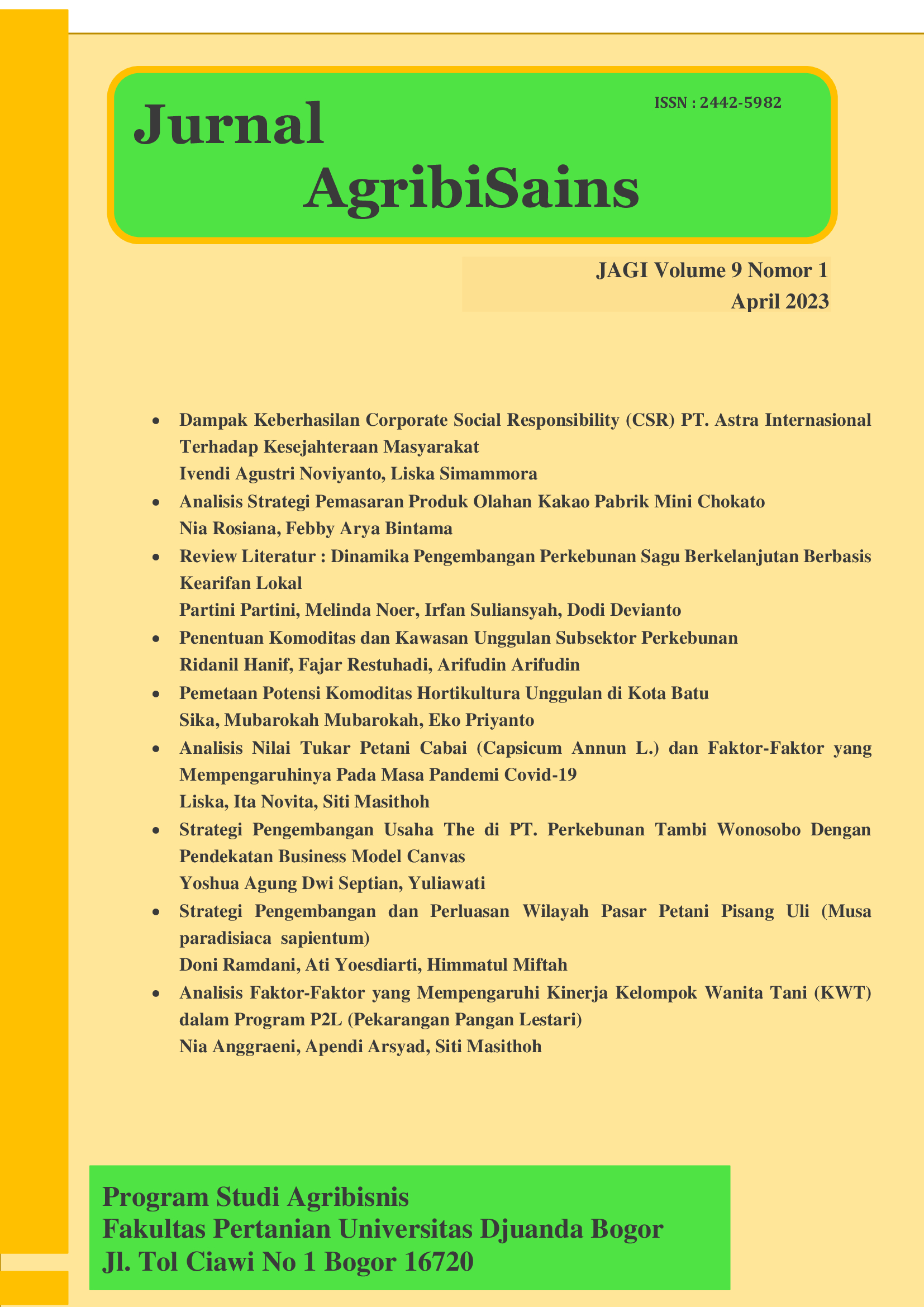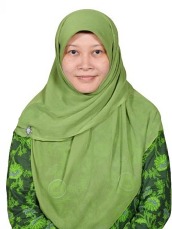Review Literatur: DINAMIKA PENGEMBANGAN PERKEBUNAN SAGU BERKELANJUTAN BERBASIS KEARIFAN LOKAL
DOI:
https://doi.org/10.30997/jagi.v9i1.6970Keywords:
Sago plantation, sustainability, local wisdom.Abstract
Sago is a native Indonesian plant that has the potential to be developed as a food and non-food source because it has several advantages, namely high starch content, resistance to climate change, being able to grow and adapt to marginal environments. Sustainability of sago plantation management must meet environmental, economic, social and institutional aspects. The purpose of this study is to identify the dynamics in the development of sago plantations and forms of local wisdom that can support the development of sustainable sago plantations. The research method used is a qualitative approach with Systematic Literature Review (SLR). The results of article review show that the development of sago plantations faces constraints of low productivity and unsustainability from social, economic, environmental culture and institutional aspects. Meanwhile in the community there are local wisdom sago management practices that have a positive effect on the five aspects of sustainability. However, previous study is still partial and does not focus on the sago plantation sector. Research questions about how to develop sustainable sago plantations based on comprehensive local wisdom is the novelty that are offered to be answered in future research.
References
Ahmad, M. (2014). Farmer Empowerment to Increase Productivity of Sago (Metroxylon sago spp) Farming. International Journal on Advanced Science, Engineering and Information Technology, 4(3), 129. https://doi.org/10.18517/ijaseit.4.3.384
Bintoro, M. H., Iqbal Nurulhaq, M., Pratama, A. J., Ahmad, F., & Ayulia, L. (2018). Growing area of sago palm and its environment. In Sago Palm (pp. 17–29). Springer, Singapore.
Bintoro, M. H., Julio, A., Muhammad, P., Fendri, N., Henry, A., Hadi, K., Iman, S., & Ayulia, B. L. (2020). Mix Farming Based on Sago Palm in Meranti Island District , Riau Province , Indonesia. 35, 106–112. https://doi.org/10.28955/alinterizbd.430769
Chua, S. N. D., Kho, E. P., Lim, S. F., & Hussain, M. H. (2021). Sago palm (Metroxylon sagu) starch yield, influencing factors and estimation from morphological traits. Advances in Materials and Processing Technologies, 00(00), 1–23. https://doi.org/10.1080/2374068X.2021.1878702
Dewi, R. K., Bintoro, M. H., & Sudradjat, D. (2016). Karakter Morfologi dan Potensi Produksi Beberapa Aksesi Sagu (Metroxylon spp.) di Kabupaten Sorong Selatan, Papua Barat. Jurnal Agronomi Indonesia (Indonesian Journal of Agronomy), 44(1), 91. https://doi.org/10.24831/jai.v44i1.12508
El Amady, M. R. (2019). Jaminan Konsumsi Rumah Tangga Petani Sagu di Desa Sungai Tohor Kabupaten Meranti, Riau. Umbara, 2(2), 88–96. https://doi.org/10.24198/umbara.v2i2.20448
Faisal, G., & Amanati, R. (2018). Akit ’ s house : identification of vernacular coastal architecture in Meranti Island. IOP Conference Series: Earth and Environmental Science. https://doi.org/10.1088/1755-1315/
Harisun, E. (2020). Typology of Fala Kanci House As a North Maluku Traditional House. Local Wisdom : Jurnal Ilmiah Kajian Kearifan Lokal, 12(2), 148–155. https://doi.org/10.26905/lw.v12i2.4005
Hasyim, H., & Muda, I. (2019). Effects of local wisdom in the form of planting prayer in the regional development on rice paddy farmers revenue in Indonesia. International Journal of Scientific and Technology Research, 8(6), 90–98.
Horn, B., Ferreira, C., & Kalantari, Z. (2022). Links between food trade, climate change and food security in developed countries: A case study of Sweden. Ambio, 51(4), 943–954. https://doi.org/10.1007/s13280-021-01623-w
Jalil, A., Yesi, & Sugiyanto, S. (2021). The Identification of Village and Tourism Potentials in facing Economic Social Threats of Communities in Peatland. JANTRO Jurnal Antropologi: Isu-Isu Sosial Budaya, 23(2), 184–191.
Järvelä, M., Jokinen, P., Huttunen, S., & Puupponen, A. (2009). Local food and reneweable energy as emerging new alternatives of rural sustainability in Finland. European Countryside, 1(2), 113–124. https://doi.org/10.2478/v10091/009-0010-8
Johari, S., Shahriman, M. I., Husaini, S. H., Shuib, A., & Ramachandran, S. (2016). Socio-Cultural-EconomicImpacts of Peat Soil Ecosystem in Mukah, Sarawak. 15th International Peat Congress 2016, 572–575.
Kadir, A., Znoj, H. Z., Suharno, Ali, A., & Komari. (2022). Sago and Oil Palm Forests: Local-Global Economic Contestation in Marind Anim Land, Papua. JSW (Jurnal Sosiologi Walisongo), 6(2), 101–116.
Markus Rawung, J. B., & Indrasti, R. (2021). The Constraints to Sago Development and Improvement Efforts in Siau Tagulandang Biaro (Sitaro) Islands. E3S Web of Conferences, 232. https://doi.org/10.1051/e3sconf/202123201029
Mohamad Naim, H., Yaakub, A. N., & Awang Hamdan, D. A. (2016). Commercialization of Sago through Estate Plantation Scheme in Sarawak: The Way Forward. International Journal of Agronomy, 2016. https://doi.org/10.1155/2016/8319542
Munawarah, S. (2020). Analisis Kelayakan Usahatani Tanaman Sagu di Desa Sampeang Kecamatan Bajo Barat Kabupaten Luwu [Universitas Muhammadiyah Makasar]. http://clik.dva.gov.au/rehabilitation-library/1-introduction-rehabilitation%0Ahttp://www.scirp.org/journal/doi.aspx?DOI=10.4236/as.2017.81005%0Ahttp://www.scirp.org/journal/PaperDownload.aspx?
Murhaini, S., & Achmadi. (2021). The farming management of Dayak People’s community based on local wisdom ecosystem in Kalimantan Indonesia. Heliyon, 7(12). https://doi.org/10.1016/j.heliyon.2021.e08578
Murod, M. (2019). Model Pengelolaan Sagu (Metroxylon sp.) Berkelanjutan di Kabupaten Kepulauan Meranti Provinsi Riau. Institut Pertanian Bogor.
Murod, M., Kusmana, C., Bintoro, M. H., Widiatmaka, N., & Hilmi, E. (2018). Analisis Struktur Kendala dalam Pengelolaan Sagu Berkelanjutan di Kabupaten Kepulauan Meranti Provinsi Riau. Buletin Palma, 19(2), 101.
Rahim, M., Basri, A., & Fauzi, H. (2019). Identification of construction system and arrangement of bajo tribe settlement based on local wisdom and environmentally friendly. In International Journal of GEOMATE (Vol. 17, Issue 64, pp. 261–266). https://doi.org/10.21660/2019.64.ICEE4
Rampisela, D. A., Sjahril, R., Lias, S. A., & Mulyadi, R. (2018). Transdisciplinary research on local community based sago forest development model for food security and marginal land utilization in the coastal area. IOP Conference Series: Earth and Environmental Science, 157(1). https://doi.org/10.1088/1755-1315/157/1/012065
Simatupang, R. O. P., & Harianja, A. H. (2018). Tingkat Preferensi Masyarakat Mengelola Sagu. Jurnal Penelitian Sosial Dan Ekonomi Kehutanan, 15(2), 129–147.
Sinapoy, S., Melamba, B., & Herman, H. (2021). Cultural Ecology and Value of Local Wisdom of The Sago Tree in The Dimension of Tolaki Tribal Society. Etnoreflika : Jurnal Sosial Dan Budaya, 10(3), 323–342. http://journal.fib.uho.ac.id/index.php/etnoreflika/article/view/1163/958
Singhal, R. S., Kennedy, J. F., Gopalakrishnan, S. M., Kaczmarek, A., Knill, C. J., & Akmar, P. F. (2008). Industrial production, processing, and utilization of sago palm-derived products. Carbohydrate Polymers, 72(1), 1–20. https://doi.org/10.1016/j.carbpol.2007.07.043
Susanti, A., Karyanto, O., Affianto, A., Ismail, I., Pudyatmoko, S., Aditya, T., Haerudin, H., & Nainggolan, H. A. (2018). Understanding the Impacts of Recurrent Peat Fires in Padang Island – Riau Province, Indonesia. Jurnal Ilmu Kehutanan, 12(1), 117. https://doi.org/10.22146/jik.34126
Thahir, R., Supriatna S, A., & Purwani, E. Y. (2014). SIMULASI MODEL DINAMIK KETERSEDIAAN SAGU MENDUKUNG KETAHANAN PANGAN: KASUS PAPUA. Prosiding Seminar Nasional Teknologi Inovatif Pascapanen Untuk Pengembangan Industri Berbasis Pertanian SIMULASI.
Thorburn, C., Simon, C., & Rowntree, J. (2013). Managing peatlands in Indonesia: A case study of small islands in Riau Province, Sumatra. October. www.monash.edu/research/sustainability-institute/
Titaley, E. (2015). Utilizing Sago to Reduce Poverty. OALib, 02(01), 1–6. https://doi.org/10.4236/oalib.1101236
Triandini, E., Jayanatha, S., Indrawan, A., Werla Putra, G., & Iswara, B. (2019). Metode Systematic Literature Review untuk Identifikasi Platform dan Metode Pengembangan Sistem Informasi di Indonesia. Indonesian Journal of Information Systems, 1(2), 63. https://doi.org/10.24002/ijis.v1i2.1916
Trisia, M. A., Metaragakusuma, A. P., Osozawa, K., & Bai, H. (2016). Promoting Sago Palm in The Context of National Level: Challenges and Strategies to Adapt to Climate Change in Indonesia. International Journal of Sustainable Future for Human Security, 4(2), 54–63. https://doi.org/10.24910/jsustain/4.2/5463
Tulalo, M. A., & Novarianto, H. (2013). Keragaman Fenotipik dan korelasi Antara Karakter Vegetatif dengan Produksi Pati Sagu Selat Panjang, Meranti. Buletin Palma, 14(1), 28–33.
Utami, W., & Nazir Salim, M. (2021). Local wisdom as a peatland management strategy of land fire mitigation in meranti regency, indonesia. Ecology, Environment and Conservation, 27, S127–S137.
Yamamoto, Y., Yoshida, T., Goto, Y., Nitta, Y., Kakuda, K., Jong, F., Hilary, L., & Hassan, A. (2003). Differences in Growth and Starch Yield of Sago Palms (Metroxylon sagu Rottb.) among Soil Types in Sarawak, Malaysia. Japanese Journal of Tropical Agriculture, 47(4), 250–259.
Yuliani, F. (2019). Effectiveness Of Peatland Restoration Implementation In Riau Province. Iapa Proceedings Conference, 319. https://doi.org/10.30589/proceedings.2018.205
Yuliani, F., & Erlina, N. (2018). Factors Affecting the Implementation of Canal Blocking Development as A Fire Prevention Solution In River Village Tohor Regency. Policy & Governance Review, 2(1), 44. https://doi.org/10.30589/pgr.v2i1.68
Zamzami, L., & Hendrawati. (2014). Kearifan Budaya Lokal Masyarakat Maritim Untuk Upaya Mitigasi Bencana Di Sumatera Barat. Jurnal Antropologi: Isu-Isu Sosial Budaya, 16(1), 37. https://doi.org/10.25077/jantro.v16i1.18
Downloads
Published
How to Cite
Issue
Section
License
Copyright (c) 2023 JURNAL AGRIBISAINS

This work is licensed under a Creative Commons Attribution-ShareAlike 4.0 International License.
Authors who publish with Jurnal AgribiSains agree to the following terms:
- Authors retain copyright and grant the journal right of first publication with the work simultaneously licensed under a Creative Commons Attribution Share-Alike 4.0 International License that allows others to share the work with an acknowledgement of the work's authorship and initial publication in Jurnal AgribiSains.
- Authors are able to enter into separate, additional contractual arrangements for the non-exclusive distribution of the journal's published version of the work (e.g., post it to an institutional repository or publish it in a book), with an acknowledgement of its initial publication in Jurnal AgribiSains.
- Authors are permitted and encouraged to post their work online (e.g., in institutional repositories or on their website) prior to and during the submission process, as it can lead to productive exchanges, as well as earlier and greater citation of published work.









